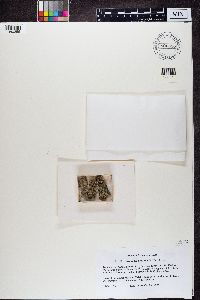University of Minnesota
http://www.umn.edu/
612-625-5000
http://www.umn.edu/
612-625-5000
Minnesota Biodiversity Atlas
Bell Museum
Dataset: MIN-Lichens
Search Criteria: South Africa; Eastern Cape; excluding cultivated/captive occurrences
1
Page 1, records 1-8 of 8
Bell Museum lichens | |
MIN:Lichens | Neofuscelia pyrenaica (Essl.) Essl. 806110[]Karnefelt, I. 171986-01-25 South Africa, Eastern Cape, Transkei, Qachas Nek |
MIN:Lichens | 806241[]Almborn, O. 105521953-11-21 South Africa, Eastern Cape |
MIN:Lichens | Parmotrema reticulatum (Taylor) M. Choisy 806291[]Karnefelt, I. 461986-01-28 South Africa, Eastern Cape, 44 km S of Tarkastad |
MIN:Lichens | Parmotrema reticulatum (Taylor) M. Choisy 850885[]Karnefelt, I. 561986-01-28 South Africa, Eastern Cape, 44 km S of Tarkastad |
MIN:Lichens | 850894[]Karnefelt, I. 11986-01-27 South Africa, Eastern Cape, Transkei, Cala Pass |
MIN:Lichens | Xanthoparmelia subconspersa (Nyl.) Hale 851185[]Kofler, L. s.n.1963-11-17 South Africa, Eastern Cape, 8 Mi From Barkly East |
MIN:Lichens | Heppia lutosa (Ach.) Nyl. 851186[]Kofler, L. s.n.1963-11-17 South Africa, Eastern Cape, 8 Mi From Barkly East |
MIN:Lichens | Normandina pulchella (Borrer) Nyl. 806336[1380355]Karnefelt, I. South Africa, Eastern Cape |
1
Page 1, records 1-8 of 8
Google Map
Google Maps is a web mapping service provided by Google that features a map that users can pan (by dragging the mouse) and zoom (by using the mouse wheel). Collection points are displayed as colored markers that when clicked on, displays the full information for that collection. When multiple species are queried (separated by semi-colons), different colored markers denote each individual species.
